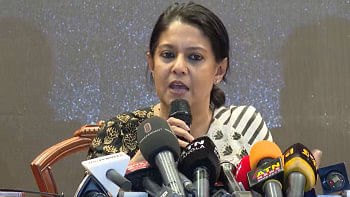Policy stances worked well in achieving targets
Headline inflation has evolved along the projected path, banks have started reducing their lending rates, the exchange rate has been stable and reserve build-up has continued.
These show that the monetary policy stance pursued by Bangladesh Bank in recent years has indeed worked in achieving its broad objectives.
Broad money growth in fiscal 2015 has languished below the Monetary Policy Statement target primarily because of shortfall in domestic credit growth, reflecting weak demand for credit both from the private sector and the central government.
Real exchange rate has appreciated despite a stable nominal exchange rate because domestic inflation has remained higher relative to inflation in our trading partner countries.
Weaknesses in financial regulation have continued.
The near term political outlook is stable as is the outlook for international commodity prices. Yet, the risks to inflation remain non-trivial. Crude prices have been firming amid considerable volatility of late and geopolitical risks are ever present.
Non-food inflation has tended to rise in the first half of 2015 in Bangladesh. With little improvement in banking sector governance, the risk of “reference loans” in state-owned banks and “insider lending” in private banks remains elevated particularly if BB switches to a cheap money policy.
Therefore, a prudent strategy is to wait for more certainty on both the domestic and international fronts.
With the 7th Five Year Plan proposing to stay on a disinflationary path (reducing inflation to 5.5 percent by fiscal 2020), the appropriate stance is to continue what has generally worked.
The central bank has to be credited for adhering to the ongoing stance with relatively minor adjustments despite pressures for switching to an expansionary policy.
The monetary programme envisages accommodating central government bank borrowing target in the fiscal 2016 budget, hopefully without monetising it. Central government bank borrowing requirements may exceed the budget target due to likely shortfall in revenue collection, aid disbursement, and non-bank borrowing targets.
However, with persistent current account deficit, the surplus in the overall balance of payments is likely to shrink leading to slower accumulation of net foreign assets.
This will create space for domestic credit growth without overshooting the broad money growth target which is rightly limited to 15.6 percent, about 2 percent higher than the 13.6 percent nominal GDP growth.
Achieving 7 percent GDP growth target while reducing inflation to 6.2 percent will be a challenge because evidence suggests Bangladesh's potential GDP growth rate is no more than 6.5 percent, given its demographics, the feeble state of physical infrastructure, and lingering political uncertainties.
BB will, therefore, have to keep strong surveillance of the economy's proclivity to overheat as growth diverges above the potential rate and adjust the monetary programme accordingly.
The writer is a lead economist at the World Bank's Dhaka office.


 For all latest news, follow The Daily Star's Google News channel.
For all latest news, follow The Daily Star's Google News channel. 



Comments